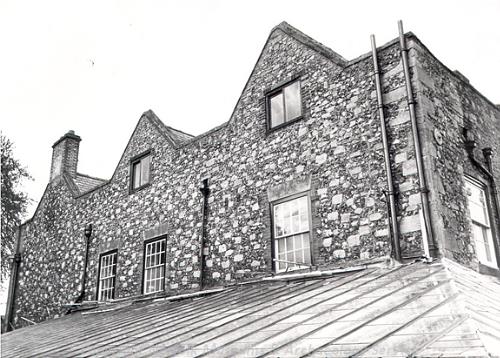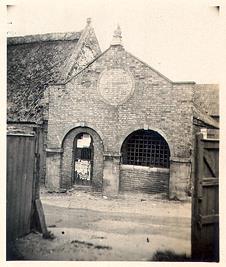By the beginning of the post medieval period Thetford had declined further. Many of the houses and monastic buildings (e.g. NHER 5748, 46329 and 5941) were decaying and the economy of the town had reached a notable low point. However, in spite of this Thetford still existed on the main road from Norwich to London during the 18th and 19th centuries as evidenced by the three coaching inns: the Anchor, the Bell (NHER 13263) and the White Hart. The arrival of the railway in 1845 (NHER 46395) offered an alternative route for passengers and trade goods to get to London.
The main industrial concern was Burrell’s Engineering Works, and a museum has been erected in part of this former factory (NHER 30551). However, the records make it clear that a number of other manufacturing and industrial activities were occurring throughout the post medieval period. These include lime burning (NHER 14346, 14348 and 14347), brick making (NHER 16861, 36830), sand extraction (NHER 44118), mining (NHER 22885) and milling (NHER 35748, 15250 and 16862). Indeed, several named mills are known in Thetford including Hollingsworth’s windmill (NHER 18024) last used in 1850, Coffee Mill (NHER 5943) and Bishop’s Mill (NHER 5931). In particular Bishop’s Mill had an interesting history – starting out as a corn mill before manufacturing paper in the late 19th century, and then plastics in the 20th century. Additionally, a set of 18th century maltings is now in use as the District Council Offices (NHER 30553) and Bidwell’s Brewery (NHER 40947), which dates to around 1850, has been converted into residential housing.
By the late 18th/early 19th century Thetford saw a revival and a great deal of rebuilding took place. This is evidenced by the huge number of listed buildings dating to this period, with particular concentrations along Magdalen Street (e.g. NHER 46317, 46381 and 46500), White Hart Street (e.g. NHER 42681, 46398 and 30554), Castle Street (e.g. NHER 40170 and 46333), Earl’s Street (e.g. NHER 46511 and 46489) and St Nicholas’ Street (e.g. NHER 46359, 46358 and 46393). Some of these refaced buildings hide much earlier medieval cores (e.g. NHER 15638).

King's House, Thetford. (© NCC)
A number of the more interesting post medieval buildings merit a mention here. King’s House (NHER 5752), a grand 18th century abode, is said to incorporate part of a hunting lodge acquired by James I in 1609. The Central Hotel (NHER 18561) dates to the 19th century but incorporates fragments of medieval window tracery in one of its gables. Inside, there is also a medieval wall painting that was restored in 2002. The Presbytery in New Town (NHER 46324) also has an intriguing past, having been built in 1829 for a Roman Catholic priest and curate.
Those not fortunate enough to reside in the more affluent dwellings were also catered for. Several almshouses (NHER 5942 and 30548) have been recorded and the Fulmerston Almshouses were in place by as early as 1610. St Barnabas’ Hospital (NHER 1092) was also originally constructed in 1836 as a workhouse, with the chapel being added in 1863. This long red brick building was still standing until 1974, at which point it was demolished.
The advent of religious non-conformism in the 19th century is also evident in Thetford. A Baptist Chapel (NHER 46488) was built on King Street in 1859, whilst a Methodist Church (NHER 46392) was erected in 1830 at Riverside walk. Perhaps the most humble of these new places of worship was the Congregational Church, now known as the United Reformed Church (NHER 46376). This simple domestic looking building dates to 1817. These new foundations offered alternative places of worship to the surviving medieval churches including the three surviving parish churches: St Cuthbert (NHER 5914), St Peter (NHER 5907) and St Mary-the-Less (NHER 5909).
A programme of civic building also occurred in the post medieval period. Several bridges (e.g. NHER 5751) were built to traverse the rivers running through the town, most notably the three Nuns Bridges (NHER 46481, 46327 and 46326) made from brick in the 19th century to allow easy crossing of the Rivers Thet and the Ouse. Thetford Gaol (NHER 46390) was also rebuilt in 1796, before being enlarged in 1816. The building was transformed into residential flats in the 20th century but panels over the doors carved with shackles and barred windows remain as a testament to its former purpose. A smaller post medieval lock-up (NHER 13261) has also been recorded.

A post medieval lock-up in Thetford. (© NCC)
More pleasant facilities were also constructed, namely a spa (see NHER 30142) with gardens and promenades known as the Spring Walks/Lammas Meadow (NHER 33717). The spa and was formed in 1818 but closed in 1838, with the main building, now known as Spring House, becoming a private residence (NHER 30142). The magnificent gardens and promenades still survive though, and are resplendent with mature planting.
The latest addition to this collection of amenities dates to the early 20th century. The present Guildhall (NHER 13262) stands in the Market Place on the site of the predecessor of 1680. It was built by H. J. Green from gault brick with stone dressings and has a slate roof with a central polygonal cupola. It has two statues; these come from the earlier buildings of 1690 and 1799, with one being a Coade stone statue of Justice. Few other structures of note have date to the pre war period, as was the case with other Norfolk urban conurbations like Norwich.
Little archaeological evidence relating to World War One has been recorded in Thetford. It is known that an army camp existed near to Barnham Cross (NHER 5945), as soldiers repaired the damage to this structure at this time. However, during World War Two a selection of defences were built around the town. The majority of these take the form of pillboxes, including one above the railway station (NHER 32170) and one at the Grammar School (NHER 5750). Another existed at the rugby club (NHER 32692), but was removed in recent years. However the most interesting pillbox is a rare type 28a pillbox (NHER 32700) with a low door and two gun loops. Concrete spigot mortar emplacements (NHER 32694, 32695, 32697 and 32699) are the only other structures from this era to survive.
One of the most recent archaeological records for Thetford deals with the Cold War period. At this time the town had a single Royal Observer Corps post (NHER 29526) situated to the northwest of the town, near to a roundabout on the A134. Sadly, it was demolished in 1994 with the only evidence to attest to its former presence being a telegraph pole.
Return to Thetford main page
Back to Saxon and Medieval Thetford